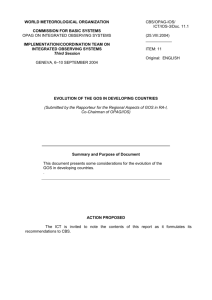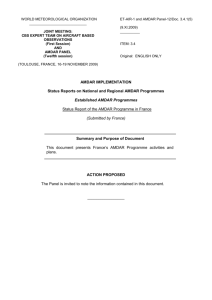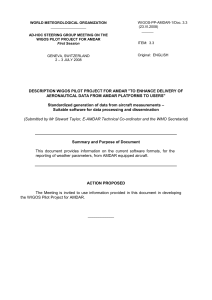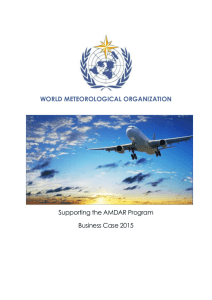amdar
advertisement
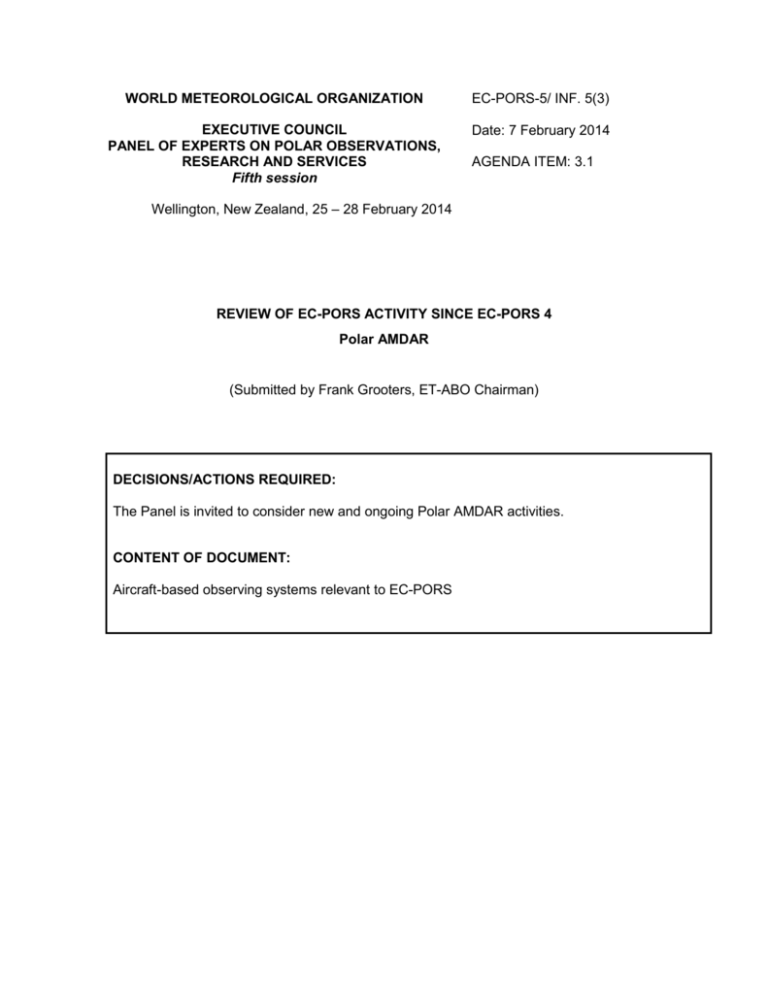
WORLD METEOROLOGICAL ORGANIZATION EC-PORS-5/ INF. 5(3) EXECUTIVE COUNCIL PANEL OF EXPERTS ON POLAR OBSERVATIONS, RESEARCH AND SERVICES Fifth session Date: 7 February 2014 AGENDA ITEM: 3.1 Wellington, New Zealand, 25 – 28 February 2014 REVIEW OF EC-PORS ACTIVITY SINCE EC-PORS 4 Polar AMDAR (Submitted by Frank Grooters, ET-ABO Chairman) DECISIONS/ACTIONS REQUIRED: The Panel is invited to consider new and ongoing Polar AMDAR activities. CONTENT OF DOCUMENT: Aircraft-based observing systems relevant to EC-PORS EC-PORS-5, INF.5(3), p. 2 Background 1. The following are extracted from the Resolutions of Congress and the Executive Council, WMO-No. 508, 2012 edition. Annex to Resolution 56 (Cg-XVI) AMENDMENTS TO THE MANUAL ON THE GLOBAL OBSERVING SYSTEM (WMO-NO. 544), VOLUME II, REGIONAL ASPECTS – THE ANTARCTIC … 7.6 Aircraft reports Members are encouraged to arrange for making, recording and distributing in realtime, observational reports from all flights to/from and within the Antarctic. … Resolution 58 (Cg-XVI) WMO POLAR ACTIVITIES … Invites Members, particularly those that have operational activities in polar regions: … (2) To provide additional observations in polar regions by using automatic weather and hydrometric stations, atmospheric soundings, and other geophysical observatories on land; by recruiting additional voluntary observing ships; by equipping aircraft with appropriate means of recording and distributing observations; and by deploying automated observing platforms on and under the sea and ice, in order to meet the needs of numerical weather prediction (NWP), hydrological services, climate studies and research programmes; EC-PORS-5, INF.5(3), p. 3 Aircraft-based observing systems relevant to EC-PORS 1. Aircraft-based observations have made a significant contribution to upper-air monitoring of the atmosphere for many decades. In recent years, the use of the aircraft platform for the automated collection of meteorological data has been considerably enhanced and expanded so as to provide more accurate, more timely and, most importantly, a much greater volume of upper-air data in support of data users and meteorological applications, including support for weather-related forecasting, climate change studies and monitoring for the Aviation Industry. The chief source of aircraftbased observations supporting the Global Observing System and the World Weather Watch Programme are derived from the Aircraft Meteorological DAta Relay (AMDAR) system , a programme for the collection of high quality meteorological data by in service commercial aircraft. 2. Up until 2012, the aircraft-based observations and the AMDAR programme was the responsibility of the AMDAR Panel, however, at the conclusion of the 15th Session of the AMDAR Panel (November 2012), the Panel formally handed over responsibility for the AMDAR Observing System to WMO and its Technical Commissions. Under the CBS and CIMO Technical Commissions, the Aircraft-based Observations Programme (ABOP, including AMDAR1) and work teams (CBS Expert Team on Aircraft-based Observing Systems, ET-ABO, and the CIMO Task Team on Aircraft-based Observations, TT-AO) have been established in order to continue the previous work of the AMDAR Panel in maintaining and developing the aircraft-based observations programme and the AMDAR Observing System, supported by the AMDAR Trust Fund and WMO Members. ET-ABO has been requested to investigate the potential to extend and expand the coverage of ABO over Polar Regions in support of EC-PORS activities and monitoring of the Polar Regions in accordance with the Manual on the GOS. 3. AMDAR is organized through a number of national and regional AMDAR programmes managed by National Meteorological & Hydrological Services (NMHS). Currently 40 airlines are cooperating and about 3000 aircraft collect around 400 000 observations daily. Fig. 1 Global AMDAR Coverage, 5 February 2014 (Courtesy NOAA/ESRL/GSD) 1 See http://www.wmo.int/pages/prog/www/GOS/ABO/ EC-PORS-5, INF.5(3), p. 4 Current Sources of Polar Aircraft-based Observations: Antarctic Region 4. There is a very limited amount of Antarctic, near-polar region level flight data. It appears that there is only one source of aircraft-based observations over the Antarctic region and transmitted on the GTS, being data derived from the Australian Antarctic Division A319 aircraft (AU0500 / AC#10357) that is equipped with the AFIRS2 system (see the NOAA/ESRL/GSD coverage map below). This data is limited to infrequent and irregular vertical profiles from the aircraft into Antarctic airports (McMurdo, Casey, Wilkins Aerodrome), depending on the southern hemisphere summer schedule of Australian Antarctic Division flights: https://secure3.aad.gov.au/proms/public/schedules/flight.cfm?season=1314 Fig. 2 AAD Flight Hobart to Wilkins Aerodrome, 2 February 2014 (Courtesy NOAA/ESRL/GSD) 2 AFIRSTM , Automated Flight Information reporting System, an AMDAR-like commercially operated observing system, produced by FLYHT Aerospace Solutions Ltd) EC-PORS-5, INF.5(3), p. 5 Fig.3 Temperature/Wind Profile Wilkins Aerodrome, 4 February 2014 (Courtesy NOAA/ESRL/GSD) Current Sources of Polar Aircraft-based Observations: Arctic Region 5. The coverage map below shows recent ABO data generated over a 24 hour period, with a limited coverage of profiles at sites above 60N to around 70N from the USA MDCRS (Alaska Airways) and E-AMDAR over Norway, Finland and Sweden. Profiles from Svalbard (Norway) are generated by NOAA Earth System Research Lab (ESRL) and the E-AMDAR programme at around 78N. Some cruise level data is generated from trans-Atlantic traffic from both AMDAR and other sources. Fig. 4 Ascent Profile (temperature, wind) from Longyearbyen (Svalbard), 6 February 2014 (Courtesy EUMETNET E-AMDAR Portal) EC-PORS-5, INF.5(3), p. 6 Fig. 5 (Near)Polar AMDAR Data from Alaska, Svalbard and North-Scandinavia (profiles and over-flight data, 6 February 2014, Courtesy NOAA/ESRL/GSD) Polar Aircraft-based Observations: Potential AMDAR expansion 6. In Canada there is great potential to sustain and expand coverage of AMDAR through both AMDAR equipped aircraft and alternative ABO systems The management of the Canadian AMDAR Programme has the intention to review various options to equip smaller aircraft from domestic airlines with the aim to provide more aircraft-based observations, among others from the Canadian polar region. ARINC3 and the NOAA NWS are considering to implement water vapour sensors (type WVSS-II) in aircraft operated by Alaska Airlines which will benefit the AMDAR observations from the Alaska region with the provision of valuable upper air moisture data not yet available in AMDAR data from Polar Regions. 7. 8. Information regarding polar routes, based on HF air-to-ground communication and provided by ARINC, shows that AMDAR observations can be expanded in the Arctic Region above 80N (see Fig. 6a and b). The ET-ABO and ARINC are reviewing this potential expansion regarding flight plans and (AMDAR suitable) aircraft types. 9. A number of US aircraft is equipped with TAMDAR4, providing AMDAR-like data, including water vapour data, over parts of Canada and Alaska. TAMDAR data is not distributed on the GTS, but is restricted data commercially available at a cost. 3 4 Aeronautical Radio Inc. (Rockwell Collins) Tropospheric Airborne Meteorological Data Reporting, Panasonic Avionics Corp. (formerly AirDat LLC) EC-PORS-5, INF.5(3), p. 7 Fig. 6a ARINC HF services from polar routes Fig. 6b Multi-day polar over-flights 10. The situation in the Antarctic regions is different from the situation in the Arctic region in that there are no commercial airports which results in trans-Atlantic flights with routes not over the Antarctic. Aircraft-based observations will therefore be depending on aircraft such as the Australian Antarctic Division provisioning and transport flights. Fig. 7 Commercial flight routes around the Antarctic ---------------------------------------------------------------
